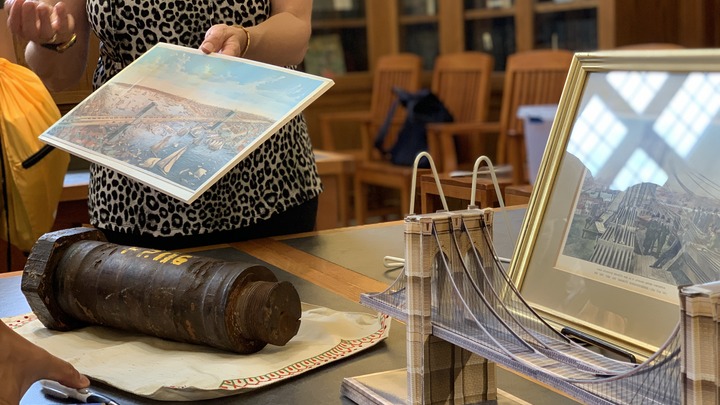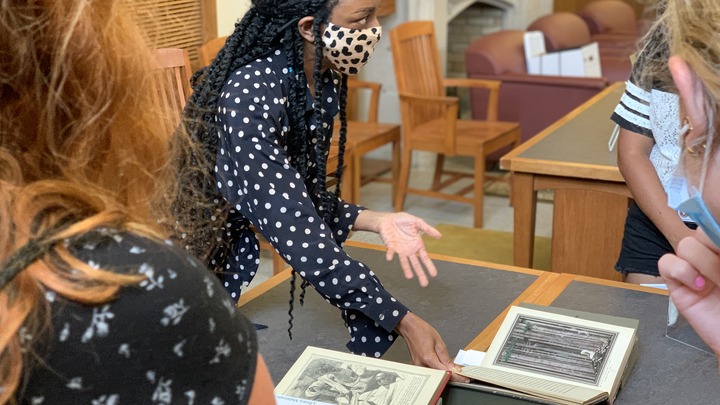Over 300 first-year Lehigh students -- some only hours after moving in -- hit the ground running at Linderman Library’s Bayer Galleria on Friday, August 20 for a hands-on introduction to select Special Collections material drawn from Lehigh history, literature, science and technology, and travel and exploration as part of the 5x10 program, “What’s So Special About Special Collections?”
Arranged as a mini-exhibit, items on display included manuscripts, monographs, fanzine publications, drawings, and books chosen from over 60,000 items in the collection. Lehigh librarians and Special Collections staff explained the historical significance of artifacts spanning several millennia and their value to researchers and scholars around the world. While items that reflect the rich history of Lehigh University are a focus of both the collection and the event, students also got hands on with a 43-pound stiffening truss taken from the Brooklyn Bridge, a medieval choir manuscript, colonial Pennsylvania maps, and Sumerian cuneiform clay tablets.
See what they saw! View more of the collection in the 5x10 Photo Album.

Lois Black, Special Collections Curator
First-year students had the opportunity to interact with an original pin removed from the Brooklyn Bridge during its 1983 centennial restoration. They were encouraged to think about the labor behind construction of the bridge, from mining iron ore, to smelting the iron, to engineering the pin, designing the bridge, and its ultimate construction. A print showing opening day ceremonies revealed the extent of the celebration in which attendees participated - as well as the impact a bridge connecting Brooklyn to Manhattan had on trade and communities.
Students were encouraged to (try to) pick up the 43-pound pin, and to look closely at a paper three-dimensional model of the bridge. To learn more, attendees were encouraged to visit Special Collections in the coming weeks to read E.F. Farrington’s History of the Building of the Great Bridge (1881), a printed primary source displayed next to the artifacts.

Jasmine Woodson, Assistant Director of Instruction and Outreach & Education Librarian
Included stories from the German Brothers Grimm (1854); Danish Hans Christian Anderson (1893); Persian, Arabic, Indian folktales Arabian Nights Entertainments (1865); and Norwegian East of the Sun West of the Moon (1914).
Discussion points included -- what are the different features of fairy tales we see in our own cultures? Are these features universal? How and why do fairy tales change over time and across cultures (ie Disney's version of Hans Christian Anderson's The Little Mermaid is a much happier version of the original very tragic story)? Are there any films, tv shows, or books we might consider modern fairy tales? (Answers here included superhero movies, Harry Potter, newer movies like Moanna and Luca, and Star Wars). And ultimately, what makes fairy tales an enduring part of human life across the world?
We also looked at the features of the book themselves including endpapers, gilded edging, marbled edging, leather binding, and vibrant color plates. There was also evidence of the previous owners of the books through dated inscriptions, one of which in the Brothers Grimm book, from 1861 and very nearly illegible!, praised the recipient of the book for his successful studies in Mathematics and Greek.
Heather Simoneau, Humanities Librarian
The idea behind this table was to show STEM students that they can apply their technical knowledge to a career in humanities fields like theater. The items were selected for their relationship to theater design - from the architecture of the building to the acoustics and lighting systems. All items were drawn from the George C. Izenour Collection.
Brian Simboli, Science, Mathematics, and Psychology Librarian
This table displayed a modern map using a Mercator projection, which served as a basis for comparison with the heart-shaped world map projection at the back of the Sylvanus 1511 version of Ptolemy’s Geographia and Ptolemy’s own map projection earlier in the volume. As new geographical information was coming in during Sylvanus’s time, there was a need to find new ways to project the information.
The table also displayed a colonial map of Pennsylvania, which enabled students to locate Bethlehem and other towns on the map and compare it to modern-day Pennsylvania.
Ilhan Citak, Librarian, Archives & Special Collections
Studying a bird’s-eye view of hand-colored Lehigh Campus 1907, and two panoramic photographs of Lehigh students (1912 and 1914), gave us opportunities to discuss the students' knowledge about history of photography, and development of Lehigh campus and environs since the early 20th century. We carefully examine the visual clues about what is depicted, such as how many dogs, how many people without a necktie, how many people that are not college age students, but also what is missing. Finally, the students learned about why there were no women in the photos, discussed "coeducation at Lehigh'' and the Soaring Together campaign, and expressed their opinions about diversity and inclusion in higher education.
Extra credit! Can you spot the dog in one of the panoramic photos in the album?
Alex Japha, Digital Archivist, Special Collections
This table provides a broad overview of the history of information. This begins with the origin of written language, represented by the circa 2000 B.C.E. Sumerian cuneiform clay tablets. Our tablets aren’t translated, but most others are records of business transactions. Lehigh has these tablets thanks to Lehigh Mining Engineering alumnus Harvey Bassler (1908), who traveled to the Middle East while working for Standard Oil. The medieval manuscript, known as the Spanish Leaves, dates to the 16th century. This manuscript is in Latin with some decorated initials and was designed to guide people through singing/chanting Catholic prayers.
The iPad completes the journey from tablets to tablets and represents all digital information. While Sumerian tablets and medieval manuscripts remain readable after hundreds or thousands of years, the iPad 2 from 2011 is already dead due to its non-chargeable battery and out-of-date software. Students should imagine how the digital material they create will be preserved and accessible in the future. Will Apple, Google, and the cloud be around in 100, 500, or 4,000 years in the future?
Casey Kies, Project Archivist
Special Collections has recently acquired a collection of fanzines collected and some published by Frank Lunney, Class of 1974. The Frank Lunney Fanzine Collection consists of self published magazines (1940s through 2000s) and other fan-based amateur and commercial publications in the areas of science-fiction, political activism, animal rights, self-publishing, etc.
During the 5x10 session, the students had a chance to see and examine the original and reproductions of selected fanzines, and participated in an interactive conversation to find out What are “zines”? Who are the zine publishers and collectors? Are there particular topics being discussed in zines in the 1940s, 1960s, 1970s? How has the zine culture reflected/shaped the political and social culture of the twentieth century and the present?
